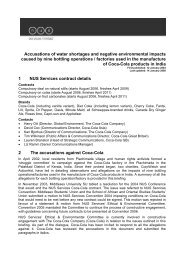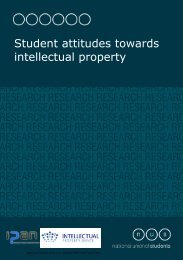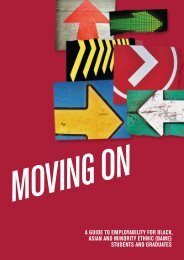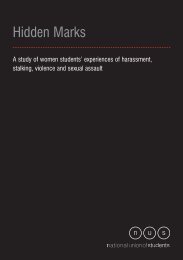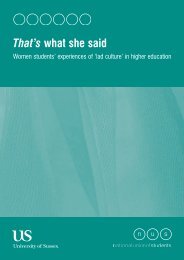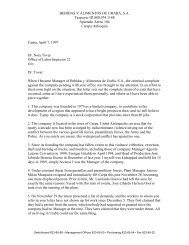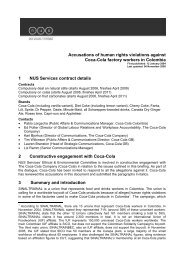No Place for Hate Crime - National Union of Students
No Place for Hate Crime - National Union of Students
No Place for Hate Crime - National Union of Students
Create successful ePaper yourself
Turn your PDF publications into a flip-book with our unique Google optimized e-Paper software.
<strong>No</strong> <strong>Place</strong> <strong>for</strong> <strong>Hate</strong><br />
This report is one <strong>of</strong> four research publications which<br />
detail the findings <strong>of</strong> a survey carried out by NUS into<br />
the extent and nature <strong>of</strong> hate incidents experienced by<br />
students in further and higher education.<br />
Its primary focus is incidents believed to be motivated<br />
by prejudice against the victim’s real or perceived<br />
sexual orientation and/or gender identity as reported<br />
in the survey, though we recognise that hate may be<br />
motivated by multiple biases and we provide some<br />
discussion on this issue.<br />
It is important to note that this report examines all<br />
incidents believed to have been motivated by some<br />
element <strong>of</strong> prejudice against the victim’s sexual<br />
orientation and/or gender identity, whatever these might<br />
be. Heterosexual and cisgender respondents, there<strong>for</strong>e,<br />
were included in our sample. However, because LGBT<br />
students surveyed were much more likely to experience<br />
a hate incident as a result <strong>of</strong> their sexual orientation or<br />
gender identity, special attention will be paid to these<br />
respondents.<br />
For clarity, incidents experienced across our entire<br />
sample – that is, including LGBT, heterosexual, those<br />
with an ‘other’ sexual orientation and/or gender identity<br />
and those who preferred not to say – will be described<br />
as ‘motivated by a prejudice against the victim’s<br />
sexual orientation and/or gender identity’. Incidents<br />
experienced by specifically LGBT respondents will be<br />
described as ‘homophobic’, ‘biphobic’ or ‘transphobic’<br />
in this report.<br />
Background<br />
What is a hate crime?<br />
The concept <strong>of</strong> hate crime is broad and complex. It<br />
is not defined by a single <strong>for</strong>m <strong>of</strong> conduct, as other<br />
crimes are, but encompasses various <strong>for</strong>ms <strong>of</strong> conduct<br />
such as:<br />
• physical abuse<br />
•<br />
•<br />
verbal abuse and harassment<br />
threats <strong>of</strong> violence<br />
• property damage and/or vandalism<br />
•<br />
•<br />
theft, including burglary and robbery<br />
the production and dissemination <strong>of</strong> hostile material<br />
(eg leaflets and graffiti).<br />
What unites these otherwise distinct <strong>of</strong>fences is the<br />
perpetrator’s motivation by prejudice towards the social<br />
group to which the victim belongs or is perceived<br />
to belong. It follows that the majority <strong>of</strong> hate crime<br />
perpetrators belong to a dominant social group. The<br />
Crown Prosecution Service reports that 75 per cent <strong>of</strong><br />
perpetrators in this country are white British; 86 per cent<br />
are also male 2 .<br />
<strong>Hate</strong> crime is particularly harmful because it is<br />
committed on the basis <strong>of</strong> some essential and<br />
unchangeable part <strong>of</strong> the victim’s identity, such as<br />
gender identity or sexual orientation. The impact<br />
suffered by the individual may include physical and<br />
behavioural as well as emotional responses, and may<br />
have long-term repercussions. At the same time, hate<br />
crimes perpetrated against an individual in effect acts<br />
as condemnation or rejection <strong>of</strong> the victim’s social<br />
group as a whole. The broader harm, there<strong>for</strong>e, is<br />
social subordination, exclusion, alienation and fear 3 .<br />
Furthermore, the insecurity suffered by the targeted<br />
groups can mean some individuals try to avoid being<br />
identified as ‘gay’ or ‘trans’ in order to reduce the<br />
likelihood <strong>of</strong> victimisation. This restricts individuals’<br />
freedom to live and express themselves according to<br />
their identities 4 .<br />
Although some incidents <strong>of</strong> hate crime amount to<br />
criminal acts and are fuelled by hate, as this report<br />
shows, the most common incidents appear neither<br />
strictly criminal nor hateful. Rather, perpetrators <strong>of</strong>ten<br />
use degrading language out <strong>of</strong> ignorance, eg on the<br />
basis <strong>of</strong> belief in stereotypes or to win respect from<br />
their peers 5 .<br />
In fact, a significant proportion <strong>of</strong> these incidents<br />
tend to be ‘everyday’ occurrences which are not, in<br />
isolation, perceived by the perpetrators to cause any<br />
real detriment. Indeed, many incidents are perpetrated<br />
by everyday people and students while their actions<br />
enjoy social acceptance. It can there<strong>for</strong>e be difficult,<br />
8



